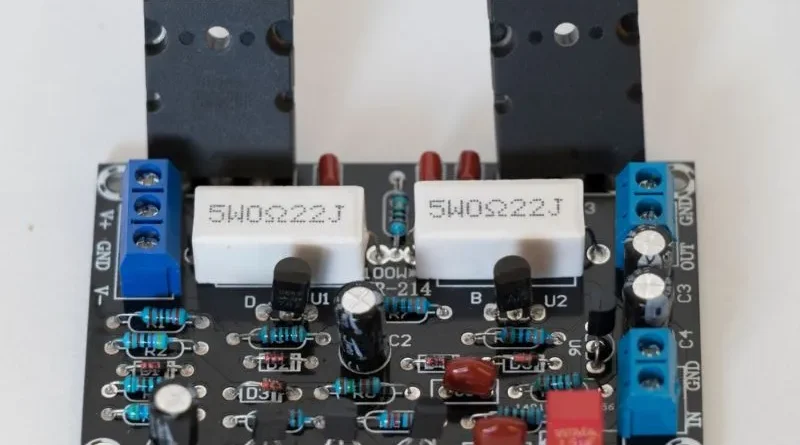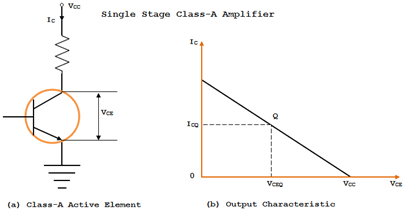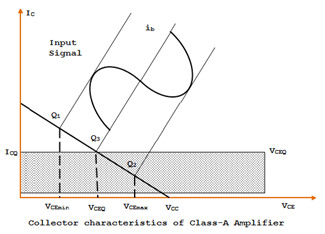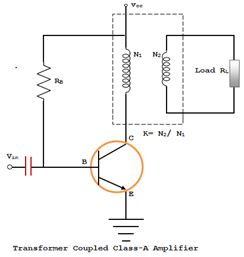
Class A amplifiers are known for their exceptional audio performance, making them the preferred choice among audiophiles and music professionals. They guarantee faithful audio reproduction with low distortion, high linearity and remarkable signal accuracy. Its unique biasing technique allows the output transistors to operate linearly throughout the waveform cycle, delivering crystal clear sound. Class A amplifiers feature wide frequency response, noise cancellation, and high gain capabilities and drive speakers of various sizes. Advanced tone controls such as bass, treble, balance and channel adjustments enhance the listening experience. Class A amplifiers offer an unparalleled solution for enthusiasts and professionals seeking unparalleled sound quality.
Class A amplifier that has a centered Q point. Therefore, transistors only work across the linear area of their load line. Therefore, it is an amplifier in which the circuit's output current flows during the entire cycle of the input signal, that is, the conduction angle is 360 Ó In other words, the transistors remain directly biased during the entire input cycle.
Classification of amplifiers

Amplifiers are classified according to operating principles: Class A for excellent sound quality but less efficiency, Class B for greater efficiency but crossover distortion, Class AB combines both, and Class D is highly efficient and often used in portable devices. Each class has advantages and disadvantages, depending on specific requirements, such as audio quality or energy efficiency. Class A amplifiers provide clean amplification but produce more heat due to constant conduction. Class D amplifiers are efficient using PWM techniques, but can cause switching noise. Class AB amplifiers provide balance with feedback circuits. Selection should take into account power requirements, audio content, and available resources.
Here are the main amplifier classifications:
Based on input signal
- Voltage Amplifier: Amplifies voltage signals and is most commonly used in electronic systems. They use a low input voltage and produce a higher output voltage.
- Current Amplifier: As the name suggests, current amplifiers amplify current signals. They use a low input current and produce a higher output current.
Based on the number of inputs and outputs
- Single Input, Single Output (SISO) Amplifier: These amplifiers have one input and one output. Common examples are common emitter transistor amplifiers and operational amplifiers (operational amplifiers).
- SIMO Amplifier (Single Input, Multiple Output): SIMO amplifiers have a single input but can drive multiple outputs. Class AB and D audio amplifiers are examples of SIMO amplifiers.
- MISO (Multiple Input, Single Output) Amplifier: MISO amplifiers have multiple inputs but produce only a single output. An example is a summing amplifier that combines different input signals.
- MIMO Amplifier (Multiple Input, Multiple Output): MIMO amplifiers have multiple inputs and outputs. They are often used in modern communication systems.
Based on frequency range
- Audio Amplifier: Amplifiers are designed to handle audio frequency signals, typically 20 Hz to 20 kHz. They are used in audio systems, headphones and speakers.
- Radio frequency (RF) amplifier: These amplifiers are designed to operate at higher frequencies, typically a few kilohertz to several gigahertz. They are used in wireless communication systems and RF circuits.
Based on configuration
- Common Emitter Amplifier (CE): A transistor amplifier with the emitter as a common connection between input and output.
- Common Base Amplifier (CB): A transistor amplifier with the base as the common connection between input and output.
- Common Collector (DC) Amplifier: A transistor amplifier with the collector as the common connection between input and output.
- Class A, B, AB, C, D and E Amplifiers are classified according to operating point and conduction angle. Each class has specific advantages and disadvantages.
Based on the reinforcement mechanism
- Analog Amplifiers: Amplifiers amplify continuous signals without quantization or discrete levels. They are used in audio and instrumentation applications.
- Digital amplifiers: Amplifiers that amplify discrete digital signals, usually using techniques such as pulse width modulation (PWM). They are commonly used in Class D audio amplifiers.
Based on application
- Operational Amplifiers (Op-Amps): High-gain differential amplifiers with versatile applications in signal processing, filtering and analog calculations.
- Power amplifier: Amplifiers that provide high-power output signals to drive speakers, motors, or other high-power devices.
- Instrument Amplifier: Special amplifiers are used to precisely measure small signals in sensor and measurement applications.
Characteristics of Class A amplifiers
- Although the transistor operates on the linear portion of the load line, the input and output waveforms are the same. For this reason Class A amplifiers are characterized by high output reliability.

-
Since its operation is limited to only a small central area of the load line, this Class A amplifier is only intended for amplifying small amplitude input signals. Large signals shift the Q point to nonlinear regions close to saturation or cutoff. Hence the distortion arises.
-
Due to the amplitude limitation of the input signal, the AC power output for each active device is small.
-
The overall efficiency of the Class A amplifier circuit is
-
The collector efficiency of a transistor is defined as
Class A amplifier: power distribution

The figure shows the connection of the common emitter transistor that forms the active element of a single-stage Class A amplifier. Figure b shows its output characteristic with the Q point centered.
When an input signal is applied, the “Q point” moves up and down from its center position. The output current will also increase or decrease relative to its resting value I. QC . Similarly, the collector-emitter voltage is V CE will rise or fall from its rest line. The average value of the collector current is I QC because positive and negative fluctuations of the input signal cause equal changes in I QC .
Transistor Power Components

Collector current (Ic)
- In a bipolar transistor (BJT), collector current (Ic) flows from the collector terminal to the emitter terminal.
- Main current represents the amplified output current in active operating mode.
Emitter current (Ie)
- Emitter current (Ie) is the total current flowing to the emitter terminal of a bipolar transistor (BJT).
- This is the sum of the base current (Ib) and the collector current (Ic) according to Kirchhoff's current law (Ie = Ib + Ic).
Base current (Ib)
- Base current (Ib) flows to the base terminal of a bipolar transistor (BJT).
- It controls the amount of collector current (Ic) flowing through the transistor and amplifies it.
Gate current (Ig)
- Gate current (Ig) flows to the gate terminal of a field effect transistor (FET).
- It controls the conductivity of the channel between the source and drain terminals in FETs.
Drain current (Id)
- Drain current (Id) flows from the drain terminal to the source terminal in a field effect transistor (FET).
- Represents the amplified output current in active operating mode.
Current source (Is)
- Source current (Is) is the total current flowing from the source terminal of a field effect transistor (FET).
- It is the sum of the gate current (Ig) and the drain current (Id), according to Kirchhoff's current law (Is = Ig + Id).
Collector current vs. emitter current (Ic vs. Ie)
- For a well-designed and properly biased BJT, the collector current (Ic) is approximately equal to the emitter current (Ie).
- This relationship is valid for most practical applications and the small difference between Ic and Ie is generally attributed to the base current (Ib).
Drain current vs. source current (Id vs. Is)
- The drain current (Id) is equal to the source current (Is) in a properly biased FET.
- This relationship is active for most FET circuits where the gate-source voltage (Vgs) is within the specified operating range.
Class A amplifier coupled to a transformer.

-
The efficiency of a direct coupled Class A amplifier is low. This problem can be solved by using a suitable transformer to connect the load to the amplifier. , as shown in the figure below.
-
Since the load is not directly connected to the collector terminal, DC collector current does not flow through it. In an ideal transformer, the resistance of the primary winding is zero. Therefore, the DC power loss in the load is zero.
-
In short, the transformer replaces the AC load with a resistive or DC load.
Conclusion
In short, Class A amplifiers excel in applications where sound quality, linearity and low distortion are more important than energy efficiency. Their remarkable achievements in these areas have earned them a special place in high-fidelity audio and precision signal processing. However, implementation requires careful considerations of thermal management and power consumption to effectively exploit the full potential of Class A amplifiers.

